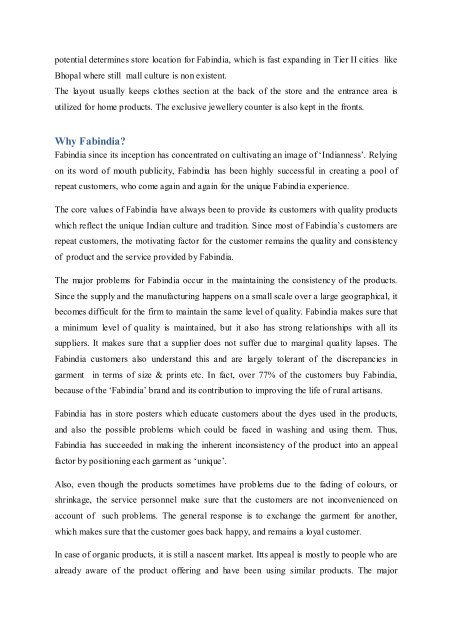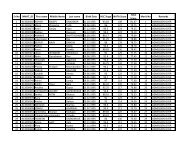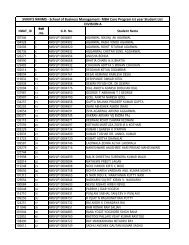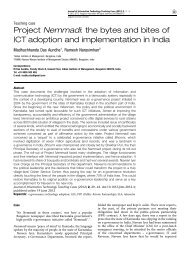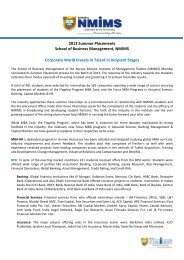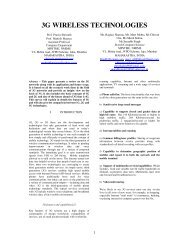Fabindia- Fabric of India - NMIMS
Fabindia- Fabric of India - NMIMS
Fabindia- Fabric of India - NMIMS
You also want an ePaper? Increase the reach of your titles
YUMPU automatically turns print PDFs into web optimized ePapers that Google loves.
potential determines store location for <strong>Fabindia</strong>, which is fast expanding in Tier II cities like<br />
Bhopal where still mall culture is non existent.<br />
The layout usually keeps clothes section at the back <strong>of</strong> the store and the entrance area is<br />
utilized for home products. The exclusive jewellery counter is also kept in the fronts.<br />
Why <strong>Fabindia</strong>?<br />
<strong>Fabindia</strong> since its inception has concentrated on cultivating an image <strong>of</strong> ‘<strong>India</strong>nness’. Relying<br />
on its word <strong>of</strong> mouth publicity, <strong>Fabindia</strong> has been highly successful in creating a pool <strong>of</strong><br />
repeat customers, who come again and again for the unique <strong>Fabindia</strong> experience.<br />
The core values <strong>of</strong> <strong>Fabindia</strong> have always been to provide its customers with quality products<br />
which reflect the unique <strong>India</strong>n culture and tradition. Since most <strong>of</strong> <strong>Fabindia</strong>’s customers are<br />
repeat customers, the motivating factor for the customer remains the quality and consistency<br />
<strong>of</strong> product and the service provided by <strong>Fabindia</strong>.<br />
The major problems for <strong>Fabindia</strong> occur in the maintaining the consistency <strong>of</strong> the products.<br />
Since the supply and the manufacturing happens on a small scale over a large geographical, it<br />
becomes difficult for the firm to maintain the same level <strong>of</strong> quality. <strong>Fabindia</strong> makes sure that<br />
a minimum level <strong>of</strong> quality is maintained, but it also has strong relationships with all its<br />
suppliers. It makes sure that a supplier does not suffer due to marginal quality lapses. The<br />
<strong>Fabindia</strong> customers also understand this and are largely tolerant <strong>of</strong> the discrepancies in<br />
garment in terms <strong>of</strong> size & prints etc. In fact, over 77% <strong>of</strong> the customers buy <strong>Fabindia</strong>,<br />
because <strong>of</strong> the ‘<strong>Fabindia</strong>’ brand and its contribution to improving the life <strong>of</strong> rural artisans.<br />
<strong>Fabindia</strong> has in store posters which educate customers about the dyes used in the products,<br />
and also the possible problems which could be faced in washing and using them. Thus,<br />
<strong>Fabindia</strong> has succeeded in making the inherent inconsistency <strong>of</strong> the product into an appeal<br />
factor by positioning each garment as ‘unique’.<br />
Also, even though the products sometimes have problems due to the fading <strong>of</strong> colours, or<br />
shrinkage, the service personnel make sure that the customers are not inconvenienced on<br />
account <strong>of</strong> such problems. The general response is to exchange the garment for another,<br />
which makes sure that the customer goes back happy, and remains a loyal customer.<br />
In case <strong>of</strong> organic products, it is still a nascent market. Itts appeal is mostly to people who are<br />
already aware <strong>of</strong> the product <strong>of</strong>fering and have been using similar products. The major


